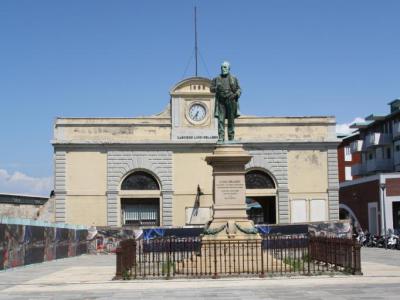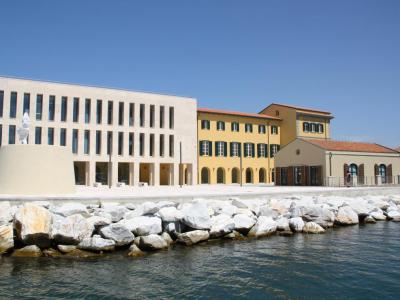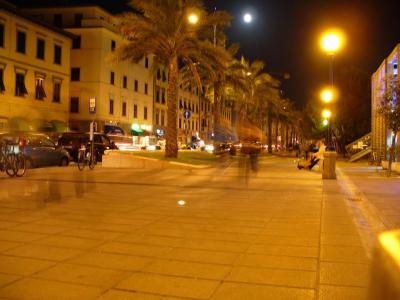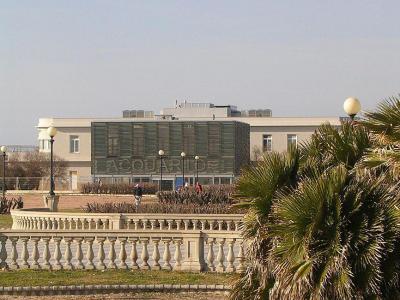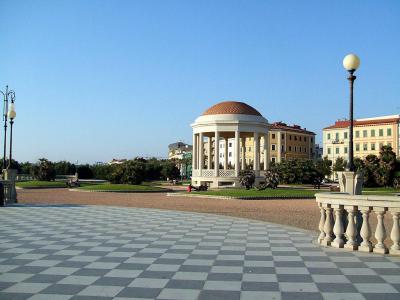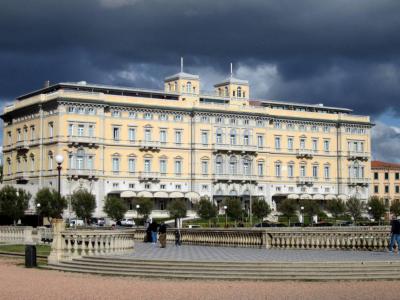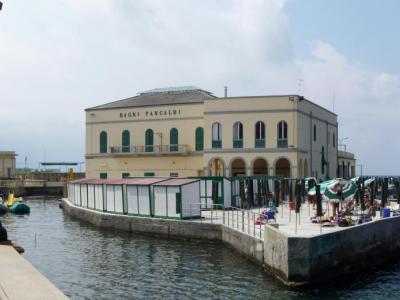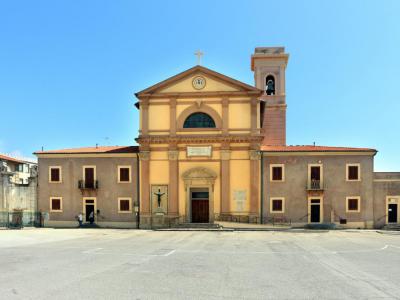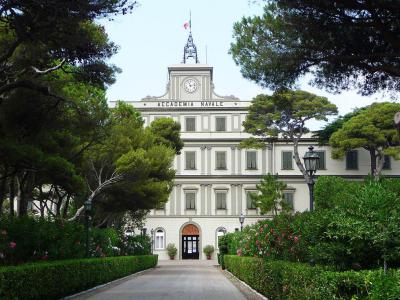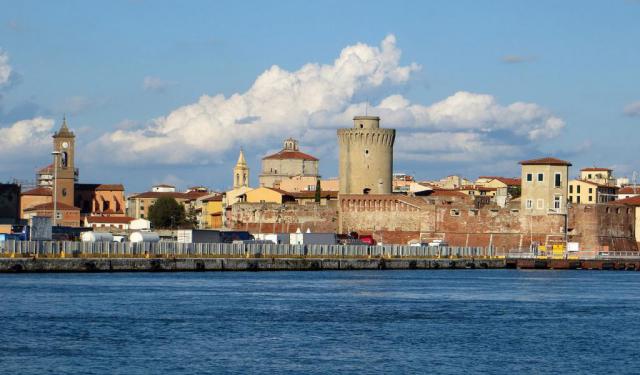Livorno Seafront Walk (Self Guided), Livorno
When the weather permits and you fancy a walk, whilst in Livorno, taking a stroll along the local seafront is a good idea. The curvy walkway, running along the coast, south of the city, is dotted with numerous points of interest. The first of them, marking the outset of the long stretch of intriguing sights further ahead, is the former Orlando shipyard.
Practically next door to it is the Scoglio della Regina (literally, “the Queen's rock”), a 19th-century bathing complex once patronized by the Queen of Etruria. Having checked that one out, you set foot on the palm-tree-lined, 19th-century promenade, known as Viale Italia, that follows the sea and runs parallel to the fields and surrounding landscape whilst being packed to the brim with various cafés, bars and restaurants on both sides.
A few more steps down the road put you in front of the splendid Terrazza Mascagni, a sweeping balustraded terrace overlooking the sea, much loved by the local families. At the north end of it sits the Aquarium of Livorno, reopened in 2010, following a major makeover.
Opposite the Terrazza you fill find one of Livorno's oldest hotels, the Hotel Palazzo, a massive building from the late 1800s that was once the city's most elegant and exclusive hotel.
A stone's throw away from it is the Bagni Pancaldi, one of oldest bathing lidos in Livorno, established in 1846, which is still quite popular in the city. A stroll past Pancaldi brings you to the square called Piazza San Jacopo in Acquaviva, with a bronze statue of Benedetto Brin, founder of the Naval Academy, in the middle.
Nearby stands the Church of San Jacopo, exposed to the wind and the sea. Right next to it is Livorno's Naval Academy which was founded in 1881 and is still one of the most important in Italy, training cadets for the Italian Navy.
For a more detailed acquaintance with the highlights of Livorno's waterfront, take this self-guided walk.
Practically next door to it is the Scoglio della Regina (literally, “the Queen's rock”), a 19th-century bathing complex once patronized by the Queen of Etruria. Having checked that one out, you set foot on the palm-tree-lined, 19th-century promenade, known as Viale Italia, that follows the sea and runs parallel to the fields and surrounding landscape whilst being packed to the brim with various cafés, bars and restaurants on both sides.
A few more steps down the road put you in front of the splendid Terrazza Mascagni, a sweeping balustraded terrace overlooking the sea, much loved by the local families. At the north end of it sits the Aquarium of Livorno, reopened in 2010, following a major makeover.
Opposite the Terrazza you fill find one of Livorno's oldest hotels, the Hotel Palazzo, a massive building from the late 1800s that was once the city's most elegant and exclusive hotel.
A stone's throw away from it is the Bagni Pancaldi, one of oldest bathing lidos in Livorno, established in 1846, which is still quite popular in the city. A stroll past Pancaldi brings you to the square called Piazza San Jacopo in Acquaviva, with a bronze statue of Benedetto Brin, founder of the Naval Academy, in the middle.
Nearby stands the Church of San Jacopo, exposed to the wind and the sea. Right next to it is Livorno's Naval Academy which was founded in 1881 and is still one of the most important in Italy, training cadets for the Italian Navy.
For a more detailed acquaintance with the highlights of Livorno's waterfront, take this self-guided walk.
How it works: Download the app "GPSmyCity: Walks in 1K+ Cities" from Apple App Store or Google Play Store to your mobile phone or tablet. The app turns your mobile device into a personal tour guide and its built-in GPS navigation functions guide you from one tour stop to next. The app works offline, so no data plan is needed when traveling abroad.
Livorno Seafront Walk Map
Guide Name: Livorno Seafront Walk
Guide Location: Italy » Livorno (See other walking tours in Livorno)
Guide Type: Self-guided Walking Tour (Sightseeing)
# of Attractions: 9
Tour Duration: 2 Hour(s)
Travel Distance: 2.3 Km or 1.4 Miles
Author: sabrina
Sight(s) Featured in This Guide:
Guide Location: Italy » Livorno (See other walking tours in Livorno)
Guide Type: Self-guided Walking Tour (Sightseeing)
# of Attractions: 9
Tour Duration: 2 Hour(s)
Travel Distance: 2.3 Km or 1.4 Miles
Author: sabrina
Sight(s) Featured in This Guide:
- Cantiere Navale Fratelli Orlando (Orlando Brothers Shipyard)
- Scoglio della Regina (Queen’s Rock)
- Viale Italia (Italy Avenue)
- Acquario di Livorno (Livorno Aquarium)
- Terrazza Mascagni (Mascagni Terrace)
- Grand Hotel Palazzo
- Bagni Pancaldi (Pancaldi Baths)
- Chiesa di San Jacopo in Acquaviva (Church of San Jacopo in Acquaviva)
- Italian Naval Academy
1) Cantiere Navale Fratelli Orlando (Orlando Brothers Shipyard)
Cantiere Navale Fratelli Orlando, known in English as Orlando Brothers Shipyard, is a historic shipyard founded in 1866. Brothers Luigi, Giuseppe, Paolo and Salvatore Orlando began ship construction in Livorno after having relocated from Genoa.
The first ship launched from the Orlando Brother Shipyard was the ironclad Conte Verde, launched for the Regia Marina. The ship was launched on July 29, 1867. Following the successful launch of the Conte Verde, the shipyard constructed gunboats Alfredo Cappellini and Faa di Bruno. Another ironclad, Lepanto, was launched in 1883.
The brothers built the Morosini Slipway, or Scalo Morosini, so that larger ships could be constructed and launched. The shipyard later launched more ships for the Regia Marina, the Argentinean General Belgrano, the Royal Hellenic Navy and the Khedive of Egypt. The shipyard started developing submarines, cruisers and destroyers during World War I.
The entrance of the shipyard is now graced by the Monument of Luigi Orlando. The monument shows a statue of Orlando standing atop a grand pedestal.
The first ship launched from the Orlando Brother Shipyard was the ironclad Conte Verde, launched for the Regia Marina. The ship was launched on July 29, 1867. Following the successful launch of the Conte Verde, the shipyard constructed gunboats Alfredo Cappellini and Faa di Bruno. Another ironclad, Lepanto, was launched in 1883.
The brothers built the Morosini Slipway, or Scalo Morosini, so that larger ships could be constructed and launched. The shipyard later launched more ships for the Regia Marina, the Argentinean General Belgrano, the Royal Hellenic Navy and the Khedive of Egypt. The shipyard started developing submarines, cruisers and destroyers during World War I.
The entrance of the shipyard is now graced by the Monument of Luigi Orlando. The monument shows a statue of Orlando standing atop a grand pedestal.
2) Scoglio della Regina (Queen’s Rock)
Scoglio Della Regina, otherwise known as Queen's Rock, is a historical spot in Livorno. It was named for Queen Maria Luisa of Etruria who enjoyed this area as a reprieve from the public eye. The queen had a natural pool created, which was fed by sea water.
A beach resort was built in this spot during the 19th century. It was one of the first bathing establishments in Livorno, built in 1846. The resort was named Bagno Squarci after the builder. It was later renamed Scoglio Della Regina, as it is known today.
The building now holds the Saint Anna School Sea Technologies and Marine Robotics Research Centre. The building sometimes opens its doors to visitors, but those visiting the city will find no shortage of things to do and see in this location even if they don't go inside. The square on which Queen's Rock stands offers a spectacular view of the Ligurian Sea. There is also a lively statue representing the queen of the rock, which was crafted by Sandro Chia in 2017.
A beach resort was built in this spot during the 19th century. It was one of the first bathing establishments in Livorno, built in 1846. The resort was named Bagno Squarci after the builder. It was later renamed Scoglio Della Regina, as it is known today.
The building now holds the Saint Anna School Sea Technologies and Marine Robotics Research Centre. The building sometimes opens its doors to visitors, but those visiting the city will find no shortage of things to do and see in this location even if they don't go inside. The square on which Queen's Rock stands offers a spectacular view of the Ligurian Sea. There is also a lively statue representing the queen of the rock, which was crafted by Sandro Chia in 2017.
3) Viale Italia (Italy Avenue)
Viale Italia, or Italy Avenue, is a promenade that snakes along the seafront from the southernmost point of La Rotunda to the Piazza Luigi Orlando. Visitors to Livorno will find themselves on Italy Avenue often as it provides access to many of the city's most notable sites. However, it is worth the time to appreciate the street itself.
Most visitors can begin their visit of Italy Avenue at Regina Margherita Barrier. This is where the street offers excellent walking paths that are unencumbered by traffic. From there, visitors will pass such spots as the Italian Naval Academy, the Church of San Jacopo in Acquaviva, the Queen's Rock, the Gazebo Terrazza on Mascagni and the Livorno Aquarium, among many others.
The street is also known for shopping and dining. There are numerous dining options for those who want to try authentic Tuscan cuisine or enjoy a gelato. Visitors should also plan to buy souvenirs at one of the many shops along the street.
Most visitors can begin their visit of Italy Avenue at Regina Margherita Barrier. This is where the street offers excellent walking paths that are unencumbered by traffic. From there, visitors will pass such spots as the Italian Naval Academy, the Church of San Jacopo in Acquaviva, the Queen's Rock, the Gazebo Terrazza on Mascagni and the Livorno Aquarium, among many others.
The street is also known for shopping and dining. There are numerous dining options for those who want to try authentic Tuscan cuisine or enjoy a gelato. Visitors should also plan to buy souvenirs at one of the many shops along the street.
4) Acquario di Livorno (Livorno Aquarium) (must see)
The Livorno Aquarium (Acquario di Livorno), situated on the scenic Terrazza Mascagni, offers visitors a deep dive into the wonders of marine life and beyond. Located near the Cetacean Sanctuary, this aquarium is home to an impressive range of aquatic species, amphibians, reptiles, and insects from all over the world.
As you begin your visit, the first room is dedicated to Diacinto Cestoni and introduces the vibrant biodiversity of the Mediterranean Sea. You’ll explore themed exhibition tanks like “The Crustaceans of the Mediterranean” and “The Colors of the Mediterranean,” where you’ll discover the rich underwater landscapes of this region.
Among the aquarium's many highlights are the Indo-Pacific tank, where Ari and Cuba, the star turtles, swim alongside zebra sharks, Napoleon fish, and blacktip reef sharks. Another crowd favorite is the tactile tank, offering visitors the unique chance to get up close and touch rays as they glide gracefully through the water. The jellyfish exhibit serves as both a visual spectacle and a gentle reminder of environmental conservation, raising awareness about the threat plastic waste poses to sea turtles and other marine creatures.
The aquarium also boasts a mesmerizing reproduction of a Greek-Roman shipwreck in its Mediterranean tank, where species like great sea bass and rockfish swim around the ruins. Moving through the exhibits, visitors encounter the vibrant world of the Caribbean Sea, home to colorful creatures such as the green moray eel, surgeonfish, and fire angel fish.
A visit to the panoramic terrace provides sweeping views of Livorno's coastline and an opportunity to reflect on the aquarium’s incredible displays. For those fascinated by land creatures, the tour concludes with a diverse range of amphibians and reptiles, including chameleons, iguanas, dart frogs, and leafcutting ants.
Ideal for families and travelers alike, the Livorno Aquarium blends education with an engaging, immersive experience, making it a must-see attraction on any visit to Livorno.
As you begin your visit, the first room is dedicated to Diacinto Cestoni and introduces the vibrant biodiversity of the Mediterranean Sea. You’ll explore themed exhibition tanks like “The Crustaceans of the Mediterranean” and “The Colors of the Mediterranean,” where you’ll discover the rich underwater landscapes of this region.
Among the aquarium's many highlights are the Indo-Pacific tank, where Ari and Cuba, the star turtles, swim alongside zebra sharks, Napoleon fish, and blacktip reef sharks. Another crowd favorite is the tactile tank, offering visitors the unique chance to get up close and touch rays as they glide gracefully through the water. The jellyfish exhibit serves as both a visual spectacle and a gentle reminder of environmental conservation, raising awareness about the threat plastic waste poses to sea turtles and other marine creatures.
The aquarium also boasts a mesmerizing reproduction of a Greek-Roman shipwreck in its Mediterranean tank, where species like great sea bass and rockfish swim around the ruins. Moving through the exhibits, visitors encounter the vibrant world of the Caribbean Sea, home to colorful creatures such as the green moray eel, surgeonfish, and fire angel fish.
A visit to the panoramic terrace provides sweeping views of Livorno's coastline and an opportunity to reflect on the aquarium’s incredible displays. For those fascinated by land creatures, the tour concludes with a diverse range of amphibians and reptiles, including chameleons, iguanas, dart frogs, and leafcutting ants.
Ideal for families and travelers alike, the Livorno Aquarium blends education with an engaging, immersive experience, making it a must-see attraction on any visit to Livorno.
5) Terrazza Mascagni (Mascagni Terrace) (must see)
Terrazza Mascagni, known in English as Mascagni Terrace, is a piazza that overlooks the Ligurian Sea. The breathtaking square has a stunning black-and-white checkered floor that provides ample room for walking along the arm of the Mediterranean. There are a total of 34,000 tiles over 8,700 square meters (just over two acres).
The area was turned into a square in 1925 using a design by engineer Enrico Salvais. It was named afer composer Pietro Mascagni. Prior to this, Mascagni Terrace was the location for the Cavalleggeri Fort.
There are many notable spots within Mascagni Terrace. One of the most historically significant is the gazebo located in the southernmost portion of the square. The original gazebo was built by Ghino Venturi in the 1930s. It was destroyed during World War II but painstakingly rebuilt to look exactly like it did when it was new.
The Mascagni Terrace is home to the Livorno Aquarium, which allows patrons to learn more about the sea life of the Mediterranean. A swimming pool in the square is open to the public. It has a large slide with a stunning view of the sea.
Those wanting to take a break from sightseeing can rest on a sun bed. Each sun bed is equipped with a foldable umbrella to offer either sun or shade. There are several restaurants in and near the square and a large number of tables that are ideal for a quick bite while enjoying the atmosphere.
Other amenities at the Mascagni Terrace include walking paths, public restrooms and a playground for young children.
The area was turned into a square in 1925 using a design by engineer Enrico Salvais. It was named afer composer Pietro Mascagni. Prior to this, Mascagni Terrace was the location for the Cavalleggeri Fort.
There are many notable spots within Mascagni Terrace. One of the most historically significant is the gazebo located in the southernmost portion of the square. The original gazebo was built by Ghino Venturi in the 1930s. It was destroyed during World War II but painstakingly rebuilt to look exactly like it did when it was new.
The Mascagni Terrace is home to the Livorno Aquarium, which allows patrons to learn more about the sea life of the Mediterranean. A swimming pool in the square is open to the public. It has a large slide with a stunning view of the sea.
Those wanting to take a break from sightseeing can rest on a sun bed. Each sun bed is equipped with a foldable umbrella to offer either sun or shade. There are several restaurants in and near the square and a large number of tables that are ideal for a quick bite while enjoying the atmosphere.
Other amenities at the Mascagni Terrace include walking paths, public restrooms and a playground for young children.
6) Grand Hotel Palazzo
The Grand Hotel Palazzo is a beautiful and historic hotel along Italy Avenue. It was commissioned by Bernardo Fabbricotti in 1888 who wished to take advantage of the tourism boom Livorno experienced at the time. The hotel was designed by Enrico Azzati.
The hotel closed only 10 years after it was opened. During World War II, it was partially destroyed and remained unused. It wasn't until 2004 that the hotel was fully restored and brought back to life.
The Grand Hotel Palazzo hosted a number of important figures during the brief time that the hotel was open in the 19th century. Some of the past guests of the hotel include King Umberto I, Queen Margherita of Savoy and Guglielmo Marconi. More recently, the Dalai Lama has stayed at the hotel and Giancarlo Giannini used the space for several film productions.
Those who wish to take a glimpse inside the hotel can try out one of its restaurants. The hotel offers a breakfast buffet on the ground floor each morning. The top-floor restaurant has traditional Italian cuisine. Guests of the hotel have access to a spa with an indoor pool and a rooftop pool with panoramic sea views.
The hotel closed only 10 years after it was opened. During World War II, it was partially destroyed and remained unused. It wasn't until 2004 that the hotel was fully restored and brought back to life.
The Grand Hotel Palazzo hosted a number of important figures during the brief time that the hotel was open in the 19th century. Some of the past guests of the hotel include King Umberto I, Queen Margherita of Savoy and Guglielmo Marconi. More recently, the Dalai Lama has stayed at the hotel and Giancarlo Giannini used the space for several film productions.
Those who wish to take a glimpse inside the hotel can try out one of its restaurants. The hotel offers a breakfast buffet on the ground floor each morning. The top-floor restaurant has traditional Italian cuisine. Guests of the hotel have access to a spa with an indoor pool and a rooftop pool with panoramic sea views.
7) Bagni Pancaldi (Pancaldi Baths)
Bagni Pancaldi, sometimes referred to as Pancaldi Baths or the Pancaldi Acquaviva, is a lovely area where visitors of Livorno can rest, relax or go for a swim. Pancaldi Baths offers a wide range of amenities including the largest swimming pool in the city.
Easily accessible from Italy Avenue, Pancaldi Baths looks over the sea. It has held this picturesque spot for nearly 200 years. Having first opened in 1840, it was the only bathing establishment until 1924.
Along with the swimming pool, Pancaldi Baths offers a sports field and boat rentals with an integrated slide. They offer multiple types of boats, including pedal boats, canoes and larger boats. Scuba diving is also available.
There is also a restaurant on site that serves authentic Tuscan cuisine. Visitors can also rent sun loungers and/or umbrellas for an afternoon of relaxation.
Easily accessible from Italy Avenue, Pancaldi Baths looks over the sea. It has held this picturesque spot for nearly 200 years. Having first opened in 1840, it was the only bathing establishment until 1924.
Along with the swimming pool, Pancaldi Baths offers a sports field and boat rentals with an integrated slide. They offer multiple types of boats, including pedal boats, canoes and larger boats. Scuba diving is also available.
There is also a restaurant on site that serves authentic Tuscan cuisine. Visitors can also rent sun loungers and/or umbrellas for an afternoon of relaxation.
8) Chiesa di San Jacopo in Acquaviva (Church of San Jacopo in Acquaviva)
Chiesa di San Jacopo in Acquaviva, or the Church of San Jacopo in Acquaviva, is a church located in the Piazza San Jacopo. It is a well-known and oft-photographed church in the city due to its location on the seaside.
The church history dates to at least 1163 though many believe it is much older. It is said that the name Acquaviva was given to the church as a spring of fresh water once flowed through the area. The spring no longer exists and verification of it has not yet been found.
The existing church was built in 1606 at the sight of the old church. A 1716 excavation uncovered the ancient church, which was restored and consecrated the following year. The church underwent remodeling in the late 19th century when a bell tower and new facade were added. The remodeling gave the church a neo-Renaissance style.
A small cemetery once existed next to the church. This was demolished to make way for expansion in the early 20th century. The church is also home to a monument to Pietro Leopoldo, Holy Roman Emperor and Grand Duke of Tuscany from 1765 to 1790.
The church history dates to at least 1163 though many believe it is much older. It is said that the name Acquaviva was given to the church as a spring of fresh water once flowed through the area. The spring no longer exists and verification of it has not yet been found.
The existing church was built in 1606 at the sight of the old church. A 1716 excavation uncovered the ancient church, which was restored and consecrated the following year. The church underwent remodeling in the late 19th century when a bell tower and new facade were added. The remodeling gave the church a neo-Renaissance style.
A small cemetery once existed next to the church. This was demolished to make way for expansion in the early 20th century. The church is also home to a monument to Pietro Leopoldo, Holy Roman Emperor and Grand Duke of Tuscany from 1765 to 1790.
9) Italian Naval Academy
The Italian Naval Academy (Accademia Navale) in Livorno is a prestigious coeducational military institution, established to provide technical training to the officers of the Italian Navy. Founded on November 6, 1881, the academy emerged from the consolidation of two naval schools: the "Royal Navy School" from the Kingdom of Sardinia in Genoa and the "Borbonica" in Naples, following the Unification of Italy and the creation of the Regia Marina. Admiral Benedetto Brin, then Secretary of the Navy, was instrumental in its foundation.
Historically, the academy occupies the grounds of the former Hospital of Saint James, built in the 1640s to quarantine crews from the Levant. The design of the academy’s complex was led by Captain Luigi Pestalozza and engineer Angiolo Badaloni, with construction commencing in 1878. The academy expanded over the years, incorporating the adjacent Saint Leopold Hospital in 1913.
The buildings, besides their military functions, briefly housed aircraft from 1923 to 1926, until the establishment of a dedicated air force academy. During World War II, bombing raids on Livorno forced the academy to relocate to Venice and later to Brindisi. After the war, extensive rebuilding efforts were needed to restore the heavily damaged structures, which lasted for two decades.
Today, the academy spans approximately 2.3 million square meters and features classrooms, laboratories, dormitories, and various recreational and educational facilities, including a swimming pool and an auditorium. A central feature is the Parade Ground (Piazza d’Armi), a large courtyard that opens towards the Ligurian Sea, where students practice sail maneuvering in preparation for service aboard the tall ship Amerigo Vespucci. The academy accommodates around 1,250 cadets and officers annually.
Historically, the academy occupies the grounds of the former Hospital of Saint James, built in the 1640s to quarantine crews from the Levant. The design of the academy’s complex was led by Captain Luigi Pestalozza and engineer Angiolo Badaloni, with construction commencing in 1878. The academy expanded over the years, incorporating the adjacent Saint Leopold Hospital in 1913.
The buildings, besides their military functions, briefly housed aircraft from 1923 to 1926, until the establishment of a dedicated air force academy. During World War II, bombing raids on Livorno forced the academy to relocate to Venice and later to Brindisi. After the war, extensive rebuilding efforts were needed to restore the heavily damaged structures, which lasted for two decades.
Today, the academy spans approximately 2.3 million square meters and features classrooms, laboratories, dormitories, and various recreational and educational facilities, including a swimming pool and an auditorium. A central feature is the Parade Ground (Piazza d’Armi), a large courtyard that opens towards the Ligurian Sea, where students practice sail maneuvering in preparation for service aboard the tall ship Amerigo Vespucci. The academy accommodates around 1,250 cadets and officers annually.
Walking Tours in Livorno, Italy
Create Your Own Walk in Livorno
Creating your own self-guided walk in Livorno is easy and fun. Choose the city attractions that you want to see and a walk route map will be created just for you. You can even set your hotel as the start point of the walk.
Livorno Introduction Walking Tour
In the early 19th century, Elizabeth Ann Seton, the first person born in the United States to be canonized a saint, had a spiritual epiphany while visiting Livorno. The city has had similar effects on visitors and immigrants. Under Medici rule, people of every ethnicity and calling would come to Livorno to find prosperity and tolerance.
There have been settlements in the Livorno area since... view more
Tour Duration: 2 Hour(s)
Travel Distance: 3.0 Km or 1.9 Miles
There have been settlements in the Livorno area since... view more
Tour Duration: 2 Hour(s)
Travel Distance: 3.0 Km or 1.9 Miles
The Most Popular Cities
/ view all



